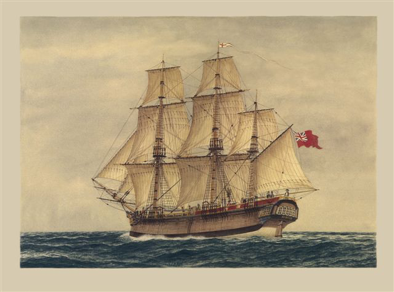November 2017
Flags have a long been a fascination of founding Society member Mr Norman Rivett as well as Garden Island in Sydney where he has worked and volunteered for more than half a century. Naturally, receipt of a pre-1967 white ensign in the Society’s office triggered questions in Norm’s enquiring mind. What flags have been flown by British ships in Australia and what was the procedure for changing ensigns? The following research notes have been provided by Mr Rivett.
When Society Member, Commander David Quick RFD, QC, RANR (rtd), recently presented the last 1801 style White Ensign worn by HMAS Supply to the Naval Historical Society I was prompted to reflect upon the various ensigns, as distinct from flags worn by ships based at Garden Island, Sydney. I found that there have been four. Of interest also was the process and reporting of how changeovers occurred.
My interest in vexillology was sparked some time ago during a visit to the large Naval Yard at Norfolk Virginia, USA One of the several dockyard canteens, was called, “Under Four Flags” commemorating the yard’s historic past. Attractively arranged around a column in the canteen are the four flags under which the yard has served during its long history. The flags are the British Union Flag of 1707, the Virginian State Flag, the Confederate State Flag and the Union Flag of the United States of the 1861 era.
In Australia’s case and Garden Island Dockyard in particular, these are the 1606 Naval Red Ensign, 1702 White Ensign, the 1801 White Ensign and the 1967 Australian White Ensign.
1606 Naval Red Ensign
HMS Sirius wore the 1606 Naval Red Ensign. That is with the 1606 Union flag in the canton.

By marine artist Frank Allen

1702 White Ensign
HM Armed Vessel Lady Nelson wore the 1702 White Ensign. That is with the Red Cross of St George on the white fly and the 1606 Union flag in the canton.
On the occasion of King George III’s birthday on Tuesday 2 June 1801 at 0845 “Lady Nelson” became the first ship in the colony to wear the 1801 Union flag (introduced in the United Kingdom on the 1 January 1801). The wearing of the 1801 White Ensign would have been in order from that moment if one had been brought out from the UK with the new Union flags.

in the Thames, from a painting in the possession of the Victorian Government
Lady Nelson was occupying Garden Island during this period.
1801 White Ensign
HMCS Protector commissioned as HMS Protector late 1900 for service in China during the Boxer Rebellion was the first Australian ship to wear the 1801 White Ensign.


Royal Australian Navy image
Extract from Navy Orders
N.O. 77, 1911 5 October
HM the King approved of the Naval Forces of the Commonwealth being designated as His Majesty’s Australian ships.
N.O. 79, 1911 5 October
Flags to be worn on HMA ships
Part IX – Distinguishing Flags and Pendants
200. All ships and vessels of the Royal Australian Navy shall fly at the stern the White Ensign as the symbol of authority of the crown, and at the jack staff the distinctive flag of the Australian Commonwealth.
Australian White Ensign
The Australian White Ensign was introduced on 1 March 1967.
Procedure for Change of Ensign
The Account by Commander David Quick RFD, QC, RANR (Ret) of the change of ensigns aboard HMAS Supply on the 1st March 1967 had a precedence aboard the “Lady Nelson” in Port Jackson on the 2 June 1801.
The Government and General Order dated 29 May 1801 states:
‘Tuesday next being the anniversary of His Majesty’s birth, will be observed as a holiday. The present Union will be hoisted at sunrise at ¼ before nine, the New South Wales Corps and Association to be under arms, when the Royal Proclamation for the union between Great Britain and Ireland will be publicly read by the Provost Marshal, and on the new Union flag being displayed at Dawe’s Point, and on board His Majesty’s armed vessel “Lady Nelson”, the military will fire three rounds which the batteries will take up, beginning at the Hills, and at the Barracks. When finished His Majesty’s armed vessel “Lady Nelson” will fire 21 guns, man ship and cheer. At noon, the salute will be repeated from the batteries, New South Wales Corps and Association will fire three rounds, and at one o’clock the “Lady Nelson” will fire 21 guns in honour of His Majesty’s birthday.’
The “Lady Nelson” was occupying Garden Island at this period. “The present Union” referred to was the 1606 Union flag and the Association was a body of volunteers called the “Sydney and Parramatta Royal Associated Corps”. Surprisingly no reference is made to the new White Ensign with the 1801 Union flag in the canton but it is inconceivable that the Admiralty would have failed to provide new ensigns along with the new Union flags.

Royal Australian Navy image.




